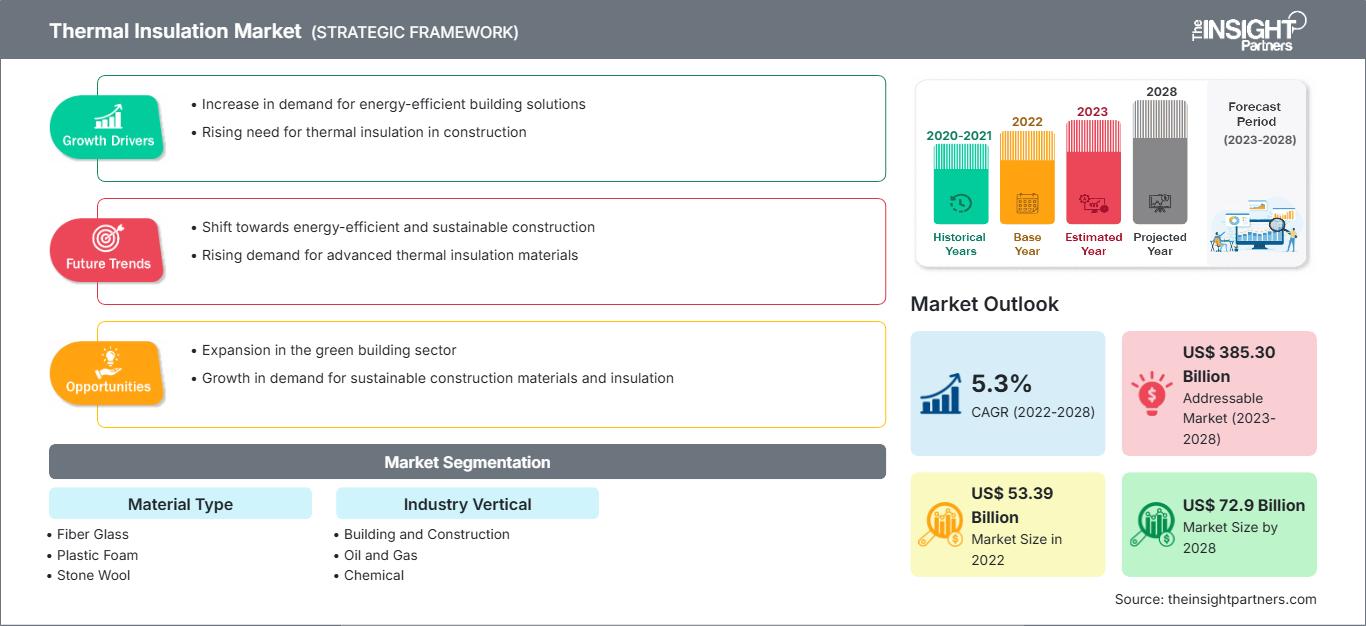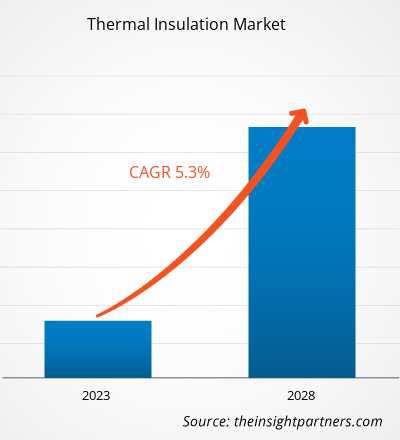Se prevé que el mercado de aislamiento térmico crezca de 53.390 millones de dólares estadounidenses en 2022 a 72.900 millones de dólares estadounidenses en 2028; se espera que crezca a una tasa de crecimiento anual compuesta (TCAC) del 5,3% entre 2022 y 2028.
La demanda de aislamiento térmico ha aumentado debido a sus ventajas. Reduce los costes energéticos y la transferencia de calor entre dos objetos a diferentes temperaturas. El material de aislamiento térmico ofrece un aislamiento que refleja, reduce y absorbe el calor radiativo. Las empresas se están centrando en ofrecer productos ligeros como el plástico, ya que es fácil de instalar y requiere menos tiempo y esfuerzo. Se espera que estos factores impulsen el crecimiento del mercado del aislamiento térmico.
Se proyecta que el mercado del aislamiento térmico experimentará un crecimiento significativo en los próximos años gracias a la sólida presencia de empresas destacadas como BASF SE, Bayer AG, ROCKWOOL A/S, Johns Manville, SAINT GOBAIN SA, Kingspan Group PLC, Dow Chemicals Company, Owens Corning, Asahi Kasei Corporation y DuPont. Una gran variedad de productos de aislamiento térmico ha captado la atención de los consumidores. Es probable que la creciente concienciación sobre los beneficios del aislamiento de alta temperatura, como la resistencia a temperaturas elevadas y choques térmicos, la baja conductividad térmica, los beneficios ambientales y la rentabilidad, impulse el crecimiento del mercado del aislamiento térmico durante el período de pronóstico.
En 2021, Asia Pacífico concentró la mayor participación en el mercado mundial de aislamiento térmico. Sin embargo, se estima que América del Norte registrará la tasa de crecimiento anual compuesta (TCAC) más alta durante el período de pronóstico. El mercado de Asia Pacífico se segmenta en China, India, Australia, Japón, Corea del Sur y el resto de Asia Pacífico. La industria de la construcción es una de las industrias en auge en Asia Pacífico debido al rápido crecimiento demográfico, lo que en última instancia genera una alta demanda de productos de aislamiento térmico. Además, el aumento de la renta disponible de los consumidores y el crecimiento de la clase media son algunos de los factores clave que impulsan el crecimiento del mercado de aislamiento térmico en la región.
Obtendrá personalización en cualquier informe, sin cargo, incluidas partes de este informe o análisis a nivel de país, paquete de datos de Excel, así como también grandes ofertas y descuentos para empresas emergentes y universidades.
Mercado de aislamiento térmico: Perspectivas estratégicas

-
Obtenga las principales tendencias clave del mercado de este informe.Esta muestra GRATUITA incluirá análisis de datos, desde tendencias del mercado hasta estimaciones y pronósticos.
Impacto de la pandemia de COVID-19 en el mercado de aislamiento térmico
Antes de la pandemia de COVID-19, el crecimiento del mercado de aislamiento térmico se debía principalmente al aumento de la demanda en la construcción. Sin embargo, el mercado se enfrentó a dificultades durante el primer trimestre de 2020 debido al cierre de empresas, la escasez de materias primas y mano de obra, y la disminución de la actividad en los sectores de la construcción y el transporte. La pandemia de COVID-19 provocó una recesión económica en los primeros meses de 2020, lo que generó dificultades financieras para los consumidores de bajos y medianos ingresos.
Además, debido a las restricciones, el cierre de muchas empresas de construcción y fabricación afectó el crecimiento del mercado del aislamiento térmico. Además, durante la pandemia, la escasez de mano de obra fue una gran preocupación para la industria del aislamiento térmico. Esto condujo a una transición hacia la mecanización, la automatización y la fabricación fuera de obra en este sector.
Perspectivas del mercado
Beneficios del uso del aislamiento térmico
El aislamiento térmico reduce la transferencia de calor y la condensación de vapor. Por lo tanto, previene la humedad, el moho, la congelación, la deformación que puede ocurrir en el edificio y el debilitamiento de las partes de hierro debido a la corrosión; y contribuye a la conservación del edificio. Además, en diversas industrias, se pueden obtener importantes ahorros de energía al disminuir la conductividad térmica en la construcción del revestimiento mediante la utilización de productos como el aislamiento BTU-BLOCK.
Según el tipo de material, el mercado global se clasifica en fibra de vidrio, espuma plástica, lana de roca, silicato de calcio, vidrio celular y otros. En 2021, el segmento de fibra de vidrio representó la mayor parte de los ingresos, y se prevé que la espuma plástica registre la mayor tasa de crecimiento durante el período de pronóstico. Por sector vertical, el mercado global se segmenta en construcción, petróleo y gas, química, aeroespacial y defensa, automotriz, farmacéutica y otros. El segmento de construcción representó la mayor parte de los ingresos.
BASF SE, Bayer AG, ROCKWOOL A/S, Johns Manville, SAINT GOBAIN SA, Kingspan Group PLC, Dow Chemicals Company, Owens Corning, Asahi Kasei Corporation y DuPont son algunos de los principales actores del mercado de aislamiento térmico. Estas empresas ofrecen una amplia gama de productos. Su presencia en regiones en desarrollo les brinda atractivas oportunidades de mercado. Los participantes del mercado están desarrollando productos innovadores y de alta calidad para satisfacer las necesidades de los clientes.
Informe destacado
- Tendencias progresivas de la industria en el mercado para ayudar a los actores a desarrollar estrategias efectivas a largo plazo
- Estrategias de crecimiento empresarial adoptadas por los mercados desarrollados y en desarrollo
- Análisis cuantitativo del tamaño del mercado de productos de aislamiento térmico de 2022 a 2028
- Estimación de la demanda mundial de aislamiento térmico
- Análisis PEST para ilustrar la eficacia de los compradores y proveedores que operan en la industria
- Desarrollos recientes para comprender el escenario del mercado competitivo
- Tendencias y perspectivas del mercado y factores que impulsan y restringen el crecimiento del mercado del aislamiento térmico
- Asistencia en el proceso de toma de decisiones destacando las estrategias de mercado que sustentan el interés comercial, lo que conduce al crecimiento del mercado.
- Tamaño del mercado de aislamiento térmico en diversos nodos
- Descripción general detallada y segmentación del mercado, así como la dinámica de la industria del aislamiento térmico.
- Tamaño del mercado de aislamiento térmico en diversas regiones con prometedoras oportunidades de crecimiento.
Perspectivas regionales del mercado de aislamiento térmico
Los analistas de The Insight Partners han explicado en detalle las tendencias regionales y los factores que influyen en el mercado del aislamiento térmico durante el período de previsión. Esta sección también analiza los segmentos del mercado del aislamiento térmico y su distribución geográfica en Norteamérica, Europa, Asia Pacífico, Oriente Medio y África, y Sudamérica y Centroamérica.
Alcance del informe de mercado de aislamiento térmico
| Atributo del informe | Detalles |
|---|---|
| Tamaño del mercado en 2022 | 53.390 millones de dólares estadounidenses |
| Tamaño del mercado en 2028 | 72.900 millones de dólares estadounidenses |
| CAGR global (2022-2028) | 5,3% |
| Datos históricos | 2020-2021 |
| período de previsión | 2023-2028 |
| Segmentos cubiertos |
Por tipo de material
|
| Regiones y países cubiertos |
América del norte
|
| Líderes del mercado y perfiles de empresas clave |
|
Densidad de los actores del mercado de aislamiento térmico: comprensión de su impacto en la dinámica empresarial
El mercado del aislamiento térmico está creciendo rápidamente, impulsado por la creciente demanda de los usuarios finales debido a factores como la evolución de las preferencias de los consumidores, los avances tecnológicos y una mayor conciencia de los beneficios del producto. A medida que aumenta la demanda, las empresas amplían su oferta, innovan para satisfacer las necesidades de los consumidores y aprovechan las nuevas tendencias, lo que impulsa aún más el crecimiento del mercado.

- Obtenga una visión general de los principales actores del mercado de aislamiento térmico.
El informe «Análisis del mercado de aislamiento térmico hasta 2028» es un estudio especializado y exhaustivo del sector de bienes de consumo, con especial atención al análisis de las tendencias del mercado global de aislamiento térmico. El informe tiene como objetivo ofrecer una visión general del mercado con una segmentación detallada.
El mercado de aislamiento térmico se segmenta por tipo de material, sector industrial y geografía. Según el tipo de material, el mercado global se divide en fibra de vidrio, espuma plástica, lana de roca, silicato de calcio, vidrio celular y otros. Según el sector industrial, el mercado global se divide en construcción, petróleo y gas, química, aeroespacial y defensa, automotriz, farmacéutica y otros. Geográficamente, el mercado se segmenta en Norteamérica, Europa, Asia Pacífico (APAC), Oriente Medio y África (MEA) y Sudamérica y Centroamérica.
Perfiles de empresas
BASF SE, Bayer AG, ROCKWOOL A/S, Johns Manville, SAINT GOBAIN SA, Kingspan Group PLC, Dow Chemicals Company, Owens Corning, Asahi Kasei Corporation y DuPont son los principales actores que operan en el mercado mundial de aislamiento térmico.
- Análisis histórico (2 años), año base, pronóstico (7 años) con CAGR
- Análisis PEST y FODA
- Tamaño del mercado, valor/volumen: global, regional y nacional
- Industria y panorama competitivo
- Conjunto de datos de Excel
Informes recientes
Informes relacionados
Testimonios
Razón para comprar
- Toma de decisiones informada
- Comprensión de la dinámica del mercado
- Análisis competitivo
- Información sobre clientes
- Pronósticos del mercado
- Mitigación de riesgos
- Planificación estratégica
- Justificación de la inversión
- Identificación de mercados emergentes
- Mejora de las estrategias de marketing
- Impulso de la eficiencia operativa
- Alineación con las tendencias regulatorias






















 Obtenga una muestra gratuita para - Mercado de aislamiento térmico
Obtenga una muestra gratuita para - Mercado de aislamiento térmico